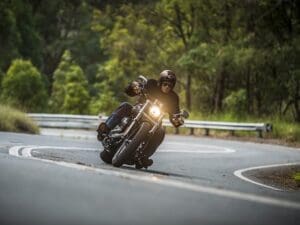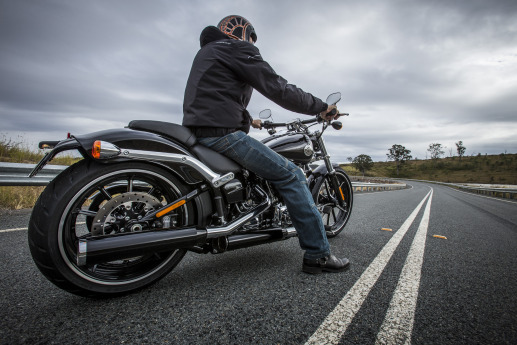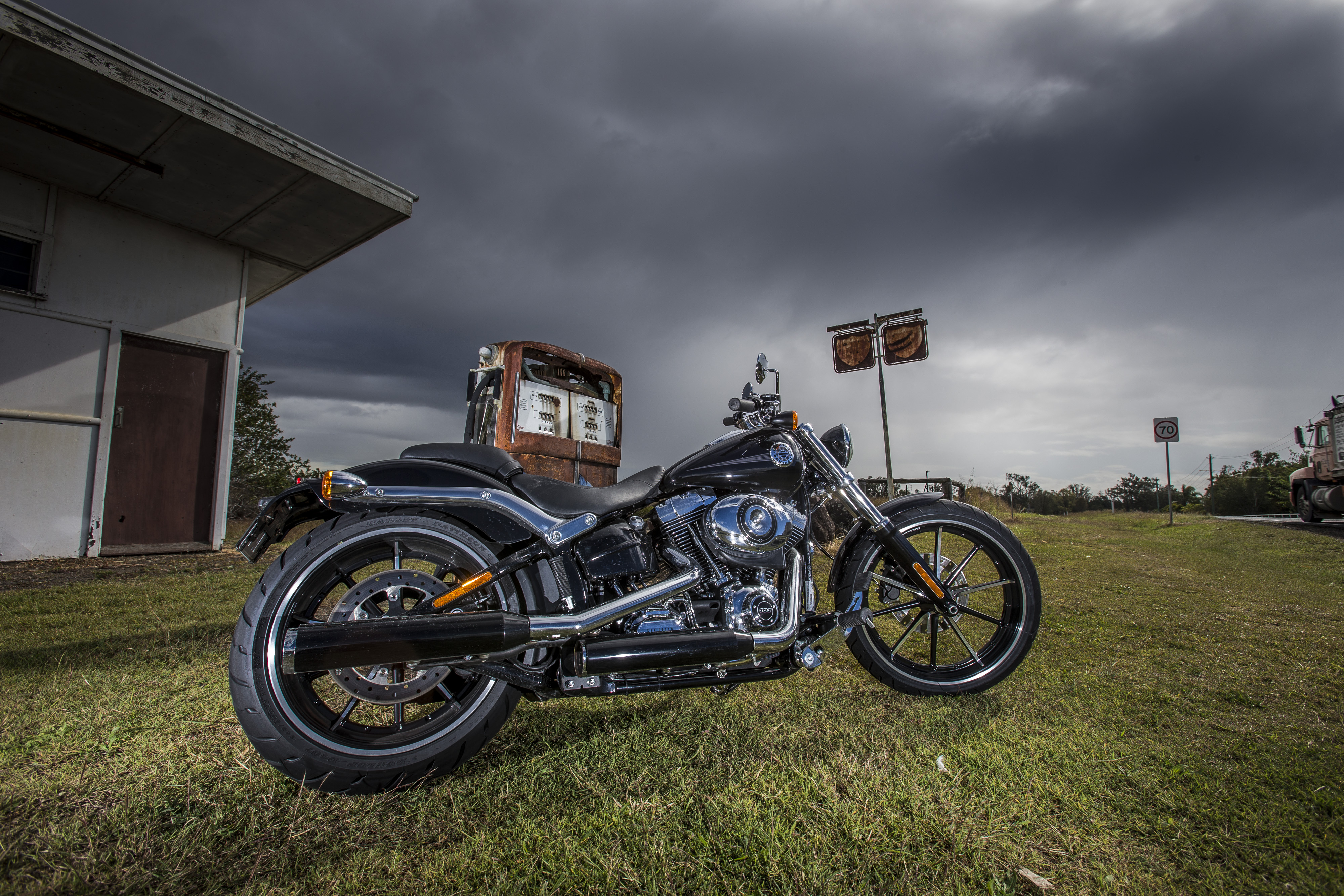
The new Harley Softail Breakout started life as a Custom Vehicle Operations (CVO) model.
While that models cost $42,990 (plus on-road costs), the “standard” model comes in at a realistic $28,990. The best news is you can accessorise the standard model up to a CVO level, except, of course for the 110 engine.
The standard Harley Softail Breakout is powered by a black powdercoat and chrome 103 Twin Cam with a six-speed Cush Drive transmission and low-maintenance belt drive.
It’s a grunty, ambling drivetrain combination with minimal mechanical noise. Gears are tall, but you can slip quickly through the cogs and ride the glorious 129Nm wave of torque, downshifting on the highway from the overdriven sixth only for passing duties.
Apart from the 103 engine, the differences between the OEM and CVO are mainly cosmetic: The “standard” Breakout doesn’t get as much chrome which makes it look a little more macho and streetwise; it doesn’t have the internal handlebar wiring so it’s a bit messy up front; it doesn’t have a leather seat although the vinyl is good quality and the saddle is quite comfortable; and it doesn’t get assist and slipper clutch pack or special two-tone paint.
It also doesn’t get the stunning 22-spoke chrome Turbine wheels, but at least the 120-spoke Gasser drag wheels are easier to clean.
The Breakout was born from the embryo of the now-defunct Softail Rocker, a great styling exercise that was difficult to ride. The Rocker was similarly slung low, but had a narrow 60mm front tyre that never worked with the 240mm rear. Riders constantly wrestled to turn the front into corners, then fought against the rear which tried to stand the bike back up again.
Harley’s Breakout design team started with the low-riding Rocker chassis, but gave it a more sensible and sturdy front end with 49mm stanchions and wider Wide Glide-style forks to accommodate a 130mm tyre.
Now, the bike’s wheels seem to be in harmony, delivering a more sensible handling proposition that welcomes corners rather than resisting them.
Another change from the Rocker is the addition of an ignition key fob with immobiliser so you can put the key in your pocket after unlocking it and not have it dangling from the ignition. The switch is still on the left of the bike rather than on the petrol tank, so it keeps the bike’s profile nice and low.
The bike features black and wide drag bars with a single instrument pod hidden behind the chrome handlebars clasp to keep the profile low and sleek. It also means you can quickly check your speed without having to look all the way down on to the tank. Despite its compact simplicity, the instrument pod includes all the info you need with the LCD screen able to display odo, two trip meters, fuel range, clock, gear indicator and revs via a toggle switch on the top side of the horn control.

Riding position is leisurely with a relaxed reach to the fat rubber pegs and a slight reach to the bars which bend to a comfortable angle for my wrists. The deep-dished seat is firm but fair, but you’ll seriously consider upgrading or at least getting an Airhawk air seat for long hauls.
Don’t be under any illusion that the Breakout is a great handler. The Softails are, by design, the worst handling of the Harleys. However, when you get used to its shortcomings and plan your corners well, it can be hustled along quite quickly. The hero blobs under the footpegs are overly long, digging into the tar and picking up the cats eyes with some nasty mid-corner consequences.
With the hidden, horizontal rear shock wound up it handles most of the imperfections South East Queensland’s flood-ravaged roads could throw at you. I didn’t hit the bump stops once, despite the short-throw 79mm rear travel. It achieves a touch over 6 litres per 100km, which is only slightly more than the claimed 5.6L/100km economy. It’s not great, but it’s ok for a Harley, probably because it is a comparative lightweight at 322kg dripping wet. That low weight also helps it pull up quickly despite having just one disc up front.
The rear seems to do most of the stopping with the centre of gravity low and rearward and a wide contact patch on the 240mm rear wheel.
There are a few gripes: The cheap screw-off fuel cap; the messy cables; overly long hero blobs; the extra part of the rear fender that holds the number plate; and the muted exhaust pipes.
However, Harley has an accessory that will fix all those problems.
Harley-Davidson FXSB Softail Breakout
- Price: $28,995
- Warranty: 2 years, unlimited km, 2 yrs roadside assist
- Service intervals: 1600/8000km
- Engine: air-cooled, fuel-injected Twin Cam 103 with four pushrod-operated, overhead valves with hydraulic, self-adjusting lifters
- Bore x Stroke: 98.4mm x 111.1mm
- Displacement 1690cc
- Torque: 129Nm @ 3000rpm
- Compression: 9.6:1
- Transmission 6-speed Cruise Drive, belt drive, wet multi-plate clutch
- Length: 2445mm
- Width: 915mm
- Height: 1040mm
- Seat: 627mm (laden), 660mm (unladen)
- Clearance: 120mm
- Rake: 35°
- Fork Angle: 37°
- Trail: 146mm
- Wheelbase: 1710mm
- Tyres: 130/60B21 63H; 240/40R18 79V Dunlop
- Wheels: 533mm x 88.9mm; 457mm x 203mm
- Fuel: 18.9L tank, 5.6L/100km
- Wet weight: 322kg
- Frame: steel tubular
- Suspension: 49mm telescopic forks, 117mm travel; hidden horizontal, coil-over rear shock, 79mm travel
- Brakes: 292mm discs, 4-piston (front), 2-piston (rear), ABS
- Colors: Black, blue and red.



